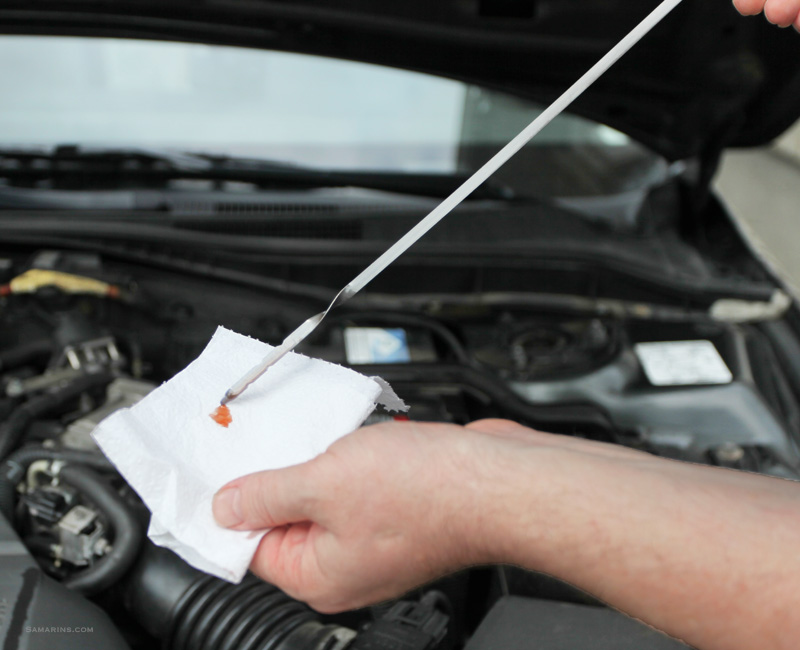The transmission fluid dipstick is usually under the car’s hood. It helps check the transmission fluid level.
Knowing where the transmission fluid dipstick is can save you time and money. Regularly checking this fluid is crucial for your car’s health. The dipstick’s location can vary depending on the car model. Some cars have it near the engine, while others place it in harder-to-reach spots.
Understanding its location helps maintain your vehicle and avoid costly repairs. This guide will help you find the transmission fluid dipstick in different car models. Read on to learn more and keep your car running smoothly.
Transmission Fluid Dipstick Location
The transmission fluid dipstick is usually found near the engine. It often has a bright handle for easy identification. Checking this dipstick ensures proper fluid levels for smooth vehicle operation.
Common Locations
The transmission fluid dipstick is usually near the engine. It’s often found near the back of the engine compartment. In some cars, the dipstick is toward the driver’s side. Other cars may have it on the passenger side. Some cars have a bright-colored handle for easy spotting. Make sure the engine is off before you check.
Differences By Vehicle Make And Model
Different cars have dipsticks in different spots. In Honda cars, it’s often near the battery. Toyota cars may have it close to the radiator. Ford cars often place it near the firewall. Some newer cars do not have a dipstick at all. Always check your owner’s manual for exact details. This will help you find it quickly and easily.
How To Locate The Dipstick
The owner’s manual is very helpful. It will show where the dipstick is. Manuals have clear pictures. Follow the steps given in it. Each car model can be different. The manual is the best guide.
Open the hood of your car. Look for the engine. Find the oil dipstick first. The transmission dipstick is often nearby. It has a bright handle. Sometimes it is red or yellow. Check near the back of the engine. It can be on the driver’s side. Be careful of hot engine parts.
Preparing To Check Transmission Fluid
To check transmission fluid, you need a few tools. A clean cloth is necessary to wipe the dipstick. A flashlight helps you see better. A funnel is useful for adding fluid if needed. Keep the car manual handy for guidance. Gloves will protect your hands from dirt and fluid.
Always park the car on a level surface. This ensures accurate fluid measurement. Turn off the engine before checking. It prevents accidents. Let the engine cool down. Hot parts can burn you. Wear gloves to keep your hands clean. Keep children and pets away. Safety first.

Credit: www.youtube.com
Steps To Check Transmission Fluid
Start your car. Let it run for a few minutes. This warms up the engine. A warm engine gives a better reading. Make sure the car is in park. Keep the handbrake on.
Open the hood. Find the transmission fluid dipstick. It is usually near the engine. Pull out the dipstick. Wipe it clean with a cloth. Put it back in. Pull it out again. Check the fluid level. The fluid should be between the two marks.
Interpreting Dipstick Readings
Dipsticks have markings to show the fluid level. These markings help to know if the fluid is low, normal, or high. Always check the fluid when the engine is warm. Levels may change if the engine is cold.
Fluid color is a key sign of its condition. Clean fluid is usually red or pink. Dirty fluid looks brown or black. Smell the fluid. Burnt smell means it needs changing.

Credit: www.autotransmatic.com
Refilling Transmission Fluid
The transmission fluid dipstick is usually located near the engine bay, close to the oil dipstick. Look for a handle labeled “transmission” or a bright color like red or yellow.
Choosing The Right Fluid
Select the correct transmission fluid for your vehicle. Check your car’s manual. Different vehicles need different fluids. Using the wrong fluid can damage your transmission. Synthetic fluids can offer better performance. Always buy from a trusted brand. Read the label carefully. Ensure it meets your car’s specifications. Ask a mechanic if you’re unsure.
Refill Procedure
First, park your car on a level surface. Engage the parking brake. Open the hood and locate the transmission dipstick. Pull out the dipstick and wipe it clean. Reinsert the dipstick fully, then remove it again. Check the fluid level on the dipstick. If it’s low, you need to refill. Use a funnel to avoid spills. Slowly pour the fluid into the dipstick tube. Do not overfill. Check the level again. Add more fluid if needed. Once done, reinsert the dipstick. Close the hood. Dispose of any old fluid responsibly.
Maintaining Transmission Health
Checking your transmission fluid is simple. The dipstick is usually near the engine. It helps you see the fluid level. Clean fluid is pink or red. Dirty fluid looks dark. Regular checks keep your car running well.
Transmission problems can be serious. Look for strange noises. Notice any fluid leaks. Pay attention to rough shifting. These signs mean you need help. Fixing issues early saves money. It also keeps you safe.

Credit: www.reddit.com
Conclusion
Finding the transmission fluid dipstick is essential for car maintenance. Keep your vehicle in good shape by checking fluid levels regularly. Follow the steps outlined to locate the dipstick easily. This helps ensure smooth transmission operation. Regular checks can prevent costly repairs.
Stay proactive with your car care. It’s simple and saves money in the long run. Always consult your vehicle’s manual for specific guidance. Ensure your car runs smoothly by keeping an eye on fluid levels. Happy driving!
